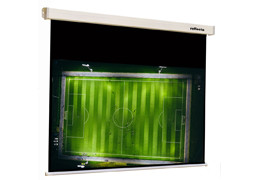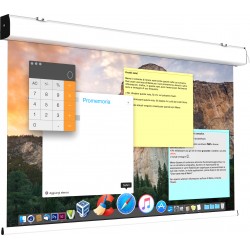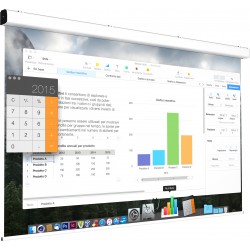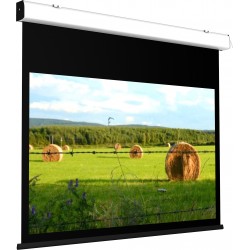The perfect solution for your home cinema

In-ceiling installation of screens in suspended ceilings
Suspended ceilings are a popular choice in modern interiors, be it offices, homes or public facilities. They offer a variety of benefits including improved acoustics, hidden lighting options and the ability to discreetly hide cables and pipes. However, when it comes to integrating audiovisual systems, especially projection solutions, one of the most common choices is the use of projection screens. In this post we will take a closer look at the advantages and disadvantages of projection screens for installation in suspended ceilings.
Advantages:
Space saving:
A projection screen built into a suspended ceiling does not take up additional space. This is particularly beneficial in rooms with limited space, such as meeting rooms or home theaters.
Aesthetics:
By installing it in the ceiling, the projection screen remains hidden when not in use and does not disrupt the aesthetic appearance of the room. This allows for a clean and minimalist design.
Functionality:
Integrating a projection screen into a suspended ceiling can be seamlessly connected to other technical installations such as projectors, speakers and lighting systems to create an immersive audiovisual experience.
Flexibility:
Projection screens for installation in suspended ceilings can be custom-made, allowing flexibility to adapt to the needs of the room. They are motorized to allow for easy entry and exit.
Disadvantages:
Installation difficulties:
Installing a projection screen in a suspended ceiling requires precise planning and installation to ensure it functions properly and is aesthetically pleasing. This can cause additional costs and effort.
Maintenance:
Maintaining a projection screen built into the ceiling can be more difficult than freestanding or wall-mounted options. This can make regular maintenance difficult.
Cost:
Projection screens for installation in suspended ceilings are usually more expensive than traditional projection screens due to the additional requirements for installation and integration into the ceiling structure.
Conclusion:
Overall, suspended ceiling projection screens offer an elegant solution to indoor audiovisual needs. Their advantages in terms of aesthetics, space saving and functionality make them an attractive option for projects that require seamless integration of audiovisual systems into modern room designs. However, it is important to carefully consider the potential disadvantages in terms of installation, size, maintenance and cost to find the best solution for the specific needs of the space.
Related products
-
reflecta Cosmos N Motor 180x180 cm 1:1
Price: €2,039.00To be used in conference rooms or in the private home theatre, the electric... -
reflecta Cosmos N Motor 200x200 cm 1:1
Price: €2,059.00To be used in conference rooms or in the private home theatre, the electric... -
reflecta Cosmos N Motor 250x250 cm 1:1
Price: €2,219.00To be used in conference rooms or in the private home theatre, the electric... -
reflecta Cosmos N Motor 300x300 cm 1:1
Price: €2,499.00To be used in conference rooms or in the private home theatre, the electric... -
reflecta Cosmos N Motor 190x140 (180x135) cm 4:3
Price: €2,099.00To be used in conference rooms or in the private home theatre, the electric... -
reflecta Cosmos N Motor 210x155 (200x150) cm 4:3
Price: €2,199.00To be used in conference rooms or in the private home theatre, the electric... -
reflecta Cosmos N Motor 260x195 (250x190) cm 4:3
Price: €2,359.00To be used in conference rooms or in the private home theatre, the electric... -
reflecta Cosmos N Motor 310x230 (300x225) cm 4:3
Price: €2,579.00To be used in conference rooms or in the private home theatre, the electric... -
reflecta Cosmos N Motor 190x131 (180x101) cm 16:9
Price: €2,189.00To be used in conference rooms or in the private home theatre, the electric... -
reflecta Cosmos N Motor 210x142 (200x112) cm 16:9
Price: €2,269.00To be used in conference rooms or in the private home theatre, the electric... -
reflecta Cosmos N Motor 310x199 (300x169) cm 16:9
Price: €2,649.00To be used in conference rooms or in the private home theatre, the electric... -
reflecta False ceiling trim kit for Cosmos N 180 cm to 260cm + 310 cm
Price: €569.00False ceiling trim kit Compatible with: 81100 reflecta Cosmos N Motor... -
reflecta False ceiling trim kit for Cosmos N 300 cm
Price: €679.00False ceiling trim kit Compatible with: 81103 reflecta Cosmos N Motor...
Related posts
-
 The world of projection screens
Posted in: Projection screens01.11.20232 LikedStationary screens vs. mobile screensRead more
The world of projection screens
Posted in: Projection screens01.11.20232 LikedStationary screens vs. mobile screensRead more -
 Manual roller projection screens
Posted in: Projection screens10.01.202433 LikedAdvantages and disadvantages of a classic choiceRead more
Manual roller projection screens
Posted in: Projection screens10.01.202433 LikedAdvantages and disadvantages of a classic choiceRead more -
 Motorized screens
Posted in: Projection screens02.02.20243 LikedComfort and technology for your home cinemaRead more
Motorized screens
Posted in: Projection screens02.02.20243 LikedComfort and technology for your home cinemaRead more -
 Framed screens for wall mounting
Posted in: Projection screens02.04.20242 LikedThe perfect solution for your home cinemaRead more
Framed screens for wall mounting
Posted in: Projection screens02.04.20242 LikedThe perfect solution for your home cinemaRead more


















